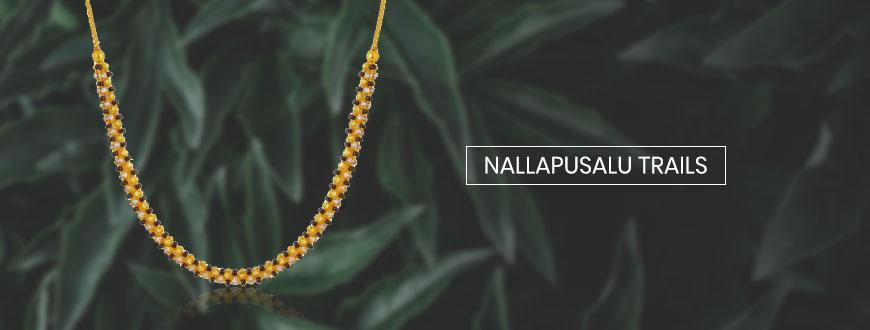Kalyan Wiki

nallapusalu trails
‘Nallapusalu’ is a Telugu word that means black beads. It is popularly known as ‘mangalsutra’ and is a quintessential jewellery element in the trousseau of the married Indian woman. ‘Mangal’ means holy and ‘sutra’ depicts the thread. During the wedding, the groom adorns a chain made of black and gold beads, attached to a pendant, around the neck of the bride. It is a common trend among married women all over India to wear a nallapusalu depicting their relationship status.
The structure of nallapusalu varies from state to state. The traditional North Indian woman wears a long mangalsutra with two lines of black beads, accompanied with some gold and a chunky pendant attached to the chain. Typically the locket is made of plain gold. Another conventional design of the North Indian nallapusalu comprises a Jadau locket. In this particular design, precious and semi-precious stones are embossed into gold by heating the gold and then cooling it again to affix the gems. No adhesives are used in this process.
Down south, the states of Maharashtra, Karnataka and Andhra Pradesh share the same kind of nallapusalu, with some variations in the pendant. The chain consists of a gold beaded string adorned with the black beads from both sides, imparting a regal look to the ornament. The locket of the nallapusalu of Andhra women consists of two circular discs made of gold, with precious and semi precious stones studded into them. It is customary that one disc is from the groom's family while the other is a gift from the bride’s father.
The traditional nallapusalu of Maharashtra and Karnataka consists of two cups that are hollow from the inside. These may be in different shapes, such as shells, beads or even flowers. There are three elaborate coin pendants that form the major part of this nallapusalu. Coral mangalsutras are also used with black, white or red beads. As times changed, the attire of the modern Indian bride changed, and it became increasingly difficult for this traditional ornament to find place with the everyday ornaments. This problem was tackled by jewellery designers who carved out impressive and sleek designer mangalsutras to match the modern bride.
The light weight nallapusalu is a single string comprising of both black and gold beads. It has a delicate pendant made of platinum or silver, studded with diamonds or other precious gems. These mangalsutras may be designed long or short according to the user’s taste. Nallapusalus with lockets carved into different geometrical patterns, coloured in different enamels, and studded with tiny rubies or diamonds to enhance their radiance are also high in demand among the ladies.
There are designs that have motifs on them that depict carvings of the Sun, Moon, stars, etc.
The ‘Lakshmi Kasu’ is an extravagant style where gold coins are attached together with the Nallapusalu, occupying most part of the jewellery. There are pendants in the shape of peacocks and other such animals and birds to impart the edgy look, while still being traditionally inclined to the Indian roots. Kundan is considered a traditional gem and it finds a special place in the making of a nallapusalu. Kundan is carefully studded on the pendant, giving the mangalsutra a ravishing touch of royalty. Mangalsutra bracelets are also widely used; these are unconventional pieces of jewellery and bestow the brides with an ultra modern look.







